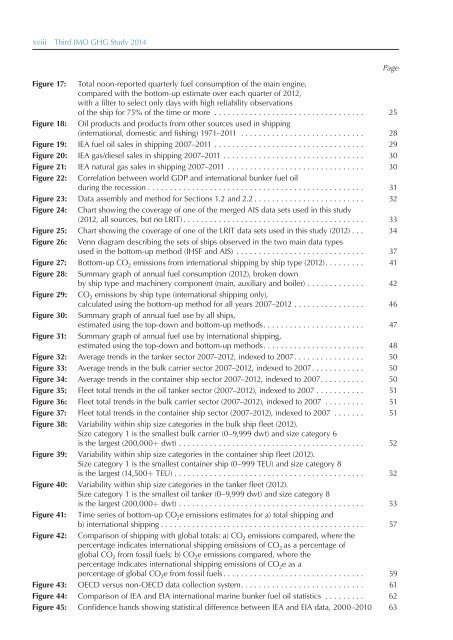MnrAq
MnrAq
MnrAq
Create successful ePaper yourself
Turn your PDF publications into a flip-book with our unique Google optimized e-Paper software.
xviii Third IMO GHG Study 2014<br />
Page<br />
Figure 17: Total noon-reported quarterly fuel consumption of the main engine,<br />
compared with the bottom-up estimate over each quarter of 2012,<br />
with a filter to select only days with high reliability observations<br />
of the ship for 75% of the time or more .................................. 25<br />
Figure 18: Oil products and products from other sources used in shipping<br />
(international, domestic and fishing) 1971–2011 ............................ 28<br />
Figure 19: IEA fuel oil sales in shipping 2007–2011 .................................. 29<br />
Figure 20: IEA gas/diesel sales in shipping 2007–2011 ................................ 30<br />
Figure 21: IEA natural gas sales in shipping 2007–2011 ............................... 30<br />
Figure 22: Correlation between world GDP and international bunker fuel oil<br />
during the recession ................................................. 31<br />
Figure 23: Data assembly and method for Sections 1.2 and 2.2 ......................... 32<br />
Figure 24: Chart showing the coverage of one of the merged AIS data sets used in this study<br />
(2012, all sources, but no LRIT) ......................................... 33<br />
Figure 25: Chart showing the coverage of one of the LRIT data sets used in this study (2012) ... 34<br />
Figure 26: Venn diagram describing the sets of ships observed in the two main data types<br />
used in the bottom-up method (IHSF and AIS) ............................. 37<br />
Figure 27: Bottom-up CO 2 emissions from international shipping by ship type (2012) ......... 41<br />
Figure 28: Summary graph of annual fuel consumption (2012), broken down<br />
by ship type and machinery component (main, auxiliary and boiler) ............. 42<br />
Figure 29: CO 2 emissions by ship type (international shipping only),<br />
calculated using the bottom-up method for all years 2007–2012 ................ 46<br />
Figure 30: Summary graph of annual fuel use by all ships,<br />
estimated using the top-down and bottom-up methods ....................... 47<br />
Figure 31: Summary graph of annual fuel use by international shipping,<br />
estimated using the top-down and bottom-up methods ....................... 48<br />
Figure 32: Average trends in the tanker sector 2007–2012, indexed to 2007 ................ 50<br />
Figure 33: Average trends in the bulk carrier sector 2007–2012, indexed to 2007 ............ 50<br />
Figure 34: Average trends in the container ship sector 2007–2012, indexed to 2007 .......... 50<br />
Figure 35: Fleet total trends in the oil tanker sector (2007–2012), indexed to 2007 ........... 51<br />
Figure 36: Fleet total trends in the bulk carrier sector (2007–2012), indexed to 2007 ......... 51<br />
Figure 37: Fleet total trends in the container ship sector (2007–2012), indexed to 2007 ....... 51<br />
Figure 38: Variability within ship size categories in the bulk ship fleet (2012).<br />
Size category 1 is the smallest bulk carrier (0–9,999 dwt) and size category 6<br />
is the largest (200,000+ dwt) .......................................... 52<br />
Figure 39: Variability within ship size categories in the container ship fleet (2012).<br />
Size category 1 is the smallest container ship (0–999 TEU) and size category 8<br />
is the largest (14,500+ TEU) ........................................... 52<br />
Figure 40: Variability within ship size categories in the tanker fleet (2012).<br />
Size category 1 is the smallest oil tanker (0–9,999 dwt) and size category 8<br />
is the largest (200,000+ dwt) .......................................... 53<br />
Figure 41: Time series of bottom-up CO 2 e emissions estimates for a) total shipping and<br />
b) international shipping .............................................. 57<br />
Figure 42: Comparison of shipping with global totals: a) CO 2 emissions compared, where the<br />
percentage indicates international shipping emissions of CO 2 as a percentage of<br />
global CO 2 from fossil fuels; b) CO 2 e emissions compared, where the<br />
percentage indicates international shipping emissions of CO 2 e as a<br />
percentage of global CO 2 e from fossil fuels ................................ 59<br />
Figure 43: OECD versus non-OECD data collection system ............................ 61<br />
Figure 44: Comparison of IEA and EIA international marine bunker fuel oil statistics ......... 62<br />
Figure 45: Confidence bands showing statistical difference between IEA and EIA data, 2000–2010 63


